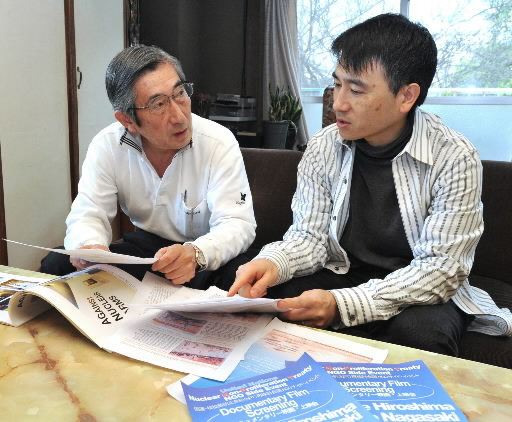Nuclear Weapons Can Be Eliminated: Chapter 9, Part 5
Apr. 21, 2010
Chapter 9: Messengers from Hiroshima
Part 5: Kazuo Tanaka and Masaru Tanaka
by Yumi Kanazaki, Staff Writer
About 2,000 people from Japan, including roughly 100 from Hiroshima, among them A-bomb survivors (hibakusha), will head to the United States in time for the Nuclear Non-proliferation Treaty (NPT) Review Conference to be held at U.N. headquarters in New York from May 3-28. They will visit the United States to appeal for the necessity of eliminating nuclear weapons. The Chugoku Shimbun will track their hopes and resolve with regard to the NPT Review Conference as well as the feelings of those who cannot visit the United States due to advanced age or poor health.
In conjunction with the Nuclear Non-proliferation Treaty (NPT) Review Conference, a documentary film entitled "No More Hiroshima, No More Nagasaki" will be screened in New York City on May 11. The film features A-bomb survivors and was made by Yukiko Nakamura, a TV producer living in Canada.
"I've had to live with the trauma of the atomic bombing," said Kazuo Tanaka, 69, in the film. "I hate the burns I suffered, yet I had no one I could confide in about my experience. And I just didn't want to talk about it." Mr. Tanaka is a green grocer and a resident of Nishi Ward, Hiroshima. He was exposed to the atomic bomb near his home in Koi (now Nishi Ward), located about 2.5 kilometers from the hypocenter. He was four years old and stretching out his arm to capture a cicada on a cherry tree. At that instant, the bomb exploded. His head, arms, and legs were severely burned.
The roof of his house caught fire and burned, and the "black rain" fell. But Mr. Tanaka has no memory of these events. What he remembers is the pain he felt when the oiled dressing applied to his burns was changed.
"The atomic bombing haunted me each day," he said. "But if I talked about it, I would feel such anguish. I was also afraid of prejudice." He did not reveal his feelings even to the members of his own family and simply focused on work after taking over the family business.
Masaru Tanaka, 40, a filmmaker and Kazuo Tanaka's third son, said, "I had never heard about my father's experience of the atomic bomb." Masaru served to help open the sealed door of his father's heart.
In the spring of 1998, Masaru met the artist Betsie Miller-Kusz, 65, at an art exhibition in the United States. She was born in January 1945 in Los Alamos, New Mexico, which was the base of development for the atomic bomb dropped on Hiroshima. Her father was a nuclear physicist.
The two "second generation" descendants hit it off. In 1999, Masaru launched a project in collaboration with Ms. Miller-Kusz, in which Masaru incorporated a collage of her drawings into his photographs to express the idea of peace in the world.
Ms. Miller-Kusz visited Hiroshima for an exhibition of their works. There she met Kazuo Tanaka and asked him: "Do you feel bitterness toward Americans for dropping the atomic bomb?"
Mr. Tanaka quickly replied, "I have no bitterness. But you should see this, too." He then rolled up the leg of his pants to expose the scars branded on his skin.
Encouraged by his son's activities, Mr. Tanaka began to ponder what he might do "to help eliminate nuclear weapons, if only a little."
In August 2005, Ms. Nakamura embarked on the shooting of her film in Hiroshima and asked Mr. Tanaka to speak out. He then shared his experience of the bombing, something he was not accustomed to, for her movie camera.
"When the film is screened, I would like people to imagine that their own loved ones could suffer the same terrible fate," said Mr. Tanaka. "They would then see that nuclear deterrence is not the answer for realizing peace." While in New York, Masaru is determined to speak for his father, who had to abandon his plans to travel to the United States due to business obligations.
(Originally published on April 18, 2010)
To comment on this article, please click the link below. Comments will be moderated and posted in a timely fashion. Comments may also appear in the Chugoku Shimbun newspaper.








